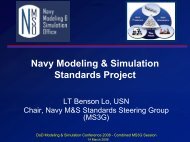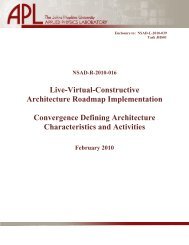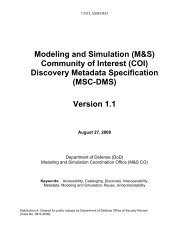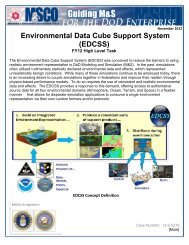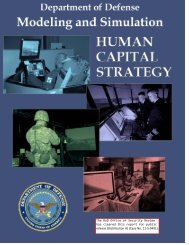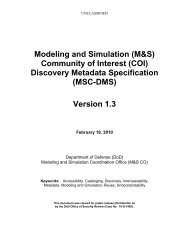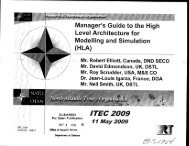LVCAR-I Convergence Final Report - Modeling & Simulation ...
LVCAR-I Convergence Final Report - Modeling & Simulation ...
LVCAR-I Convergence Final Report - Modeling & Simulation ...
You also want an ePaper? Increase the reach of your titles
YUMPU automatically turns print PDFs into web optimized ePapers that Google loves.
Live-Virtual-Constructive Architecture Roadmap Implementation,<br />
<strong>Convergence</strong> <strong>Final</strong> <strong>Report</strong><br />
3.4.1 HLA <strong>Convergence</strong> Assessment<br />
Extending support to HLA for multi-architecture interoperability should be a fairly<br />
straightforward evolutionary step. Consider that if each federate was engineered to work as<br />
described by its simulation object model (SOM), whereby the SOM is used to declare the<br />
federate’s simulation data exchange capabilities, then it would be fairly straightforward to map<br />
various federation object models (FOMs) used for federation participation to a federate’s SOM.<br />
However, the reality is that this flexibility is not commonplace for HLA federations. The<br />
majority of HLA federates are built to work with a FOM (not a SOM). Because the exchange<br />
capabilities of a federate are often built with a FOM in mind, not a SOM, the refactoring and<br />
recompilation of the federate is often needed for any new FOM (or RTI) to which it must adhere.<br />
The bottom line is that most HLA federates are designed to work with one FOM, one<br />
version of the HLA standard, and one RTI. However, as described by the IEEE 1516 HLA<br />
standard [Distributed Interactive <strong>Simulation</strong> Committee of the IEEE Computer Society, 1995,<br />
1998], it is possible to support concurrent federation executions. This means that more than one<br />
FOM may exist and be used among many federates, but again, most federates are limited to<br />
supporting just one. If one couples these limitations with the need for HLA federates to<br />
participate in exercises that may consist of simulations supporting other architectures, including<br />
TENA, DIS, CTIA, or other variants of HLA, the breadth of limitations that need to be overcome<br />
is apparent.<br />
It is through CSI that principles such as the CSI coupler concept described previously for<br />
SOM-based HLA federates can be used. A CSI coupler module would allow a FOM-oriented<br />
federate to more quickly adapt to support other types of FOMs. This would also facilitate multi-<br />
FOM participation, which has always been an intended capability of HLA. Furthermore, a CSI<br />
coupler module could help eliminate RTI vendor dependence for federation executions, allowing<br />
large numbers of federates to interoperate. It is through CSI that federates adhering to different<br />
HLA variants and simulations adhering to other interoperability standards can interoperate<br />
cooperatively without requiring major modifications (i.e., refactoring and recompilation) or large<br />
laden gateways.<br />
3.4.2 HLA RTI Implementation<br />
The need will exist for RTIs to use additional code that supports the adaptation of FOMs<br />
to what is anticipated to be a Universal Data Exchange Model (UDEM), which reflects the data<br />
exchanged through CSI. The FOM-to-UDEM adaptation is identified as a transform module,<br />
located within the CSI coupler.<br />
The anticipation is that RTI vendors could help develop the necessary CSI coupler<br />
software, which exploits and leverages its RTI, for their customers. In addition, because of the<br />
FOM-to-UDEM transform modules that are anticipated, it will likely be necessary for RTI<br />
vendors to provide a means for their customers to integrate either stock or custom transform<br />
modules and allow their customers to recompile a coupler with their integrated RTI library.<br />
Page 17



